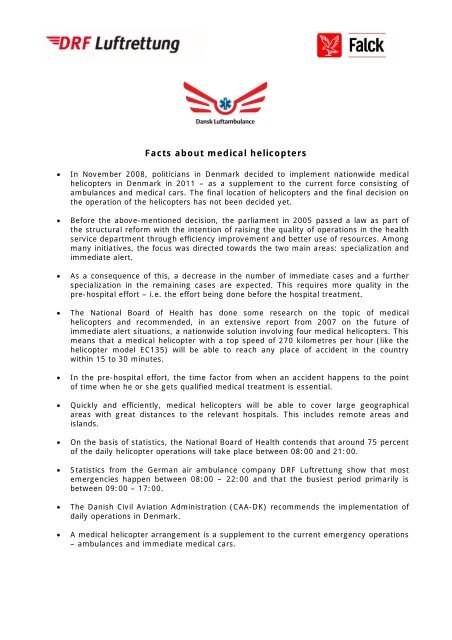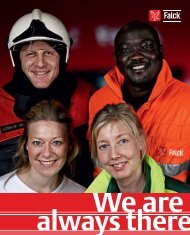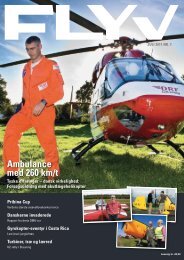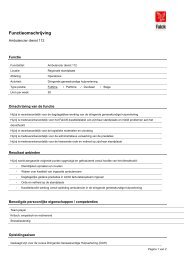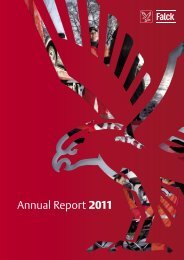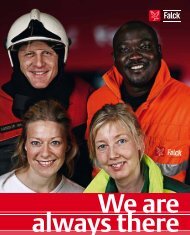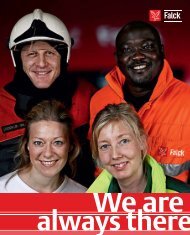The Board of Directors of Dansk Luftambulance A/S - Falck
The Board of Directors of Dansk Luftambulance A/S - Falck
The Board of Directors of Dansk Luftambulance A/S - Falck
Create successful ePaper yourself
Turn your PDF publications into a flip-book with our unique Google optimized e-Paper software.
Facts about medical helicopters<br />
• In November 2008, politicians in Denmark decided to implement nationwide medical<br />
helicopters in Denmark in 2011 – as a supplement to the current force consisting <strong>of</strong><br />
ambulances and medical cars. <strong>The</strong> final location <strong>of</strong> helicopters and the final decision on<br />
the operation <strong>of</strong> the helicopters has not been decided yet.<br />
• Before the above-mentioned decision, the parliament in 2005 passed a law as part <strong>of</strong><br />
the structural reform with the intention <strong>of</strong> raising the quality <strong>of</strong> operations in the health<br />
service department through efficiency improvement and better use <strong>of</strong> resources. Among<br />
many initiatives, the focus was directed towards the two main areas: specialization and<br />
immediate alert.<br />
• As a consequence <strong>of</strong> this, a decrease in the number <strong>of</strong> immediate cases and a further<br />
specialization in the remaining cases are expected. This requires more quality in the<br />
pre-hospital effort – i.e. the effort being done before the hospital treatment.<br />
• <strong>The</strong> National <strong>Board</strong> <strong>of</strong> Health has done some research on the topic <strong>of</strong> medical<br />
helicopters and recommended, in an extensive report from 2007 on the future <strong>of</strong><br />
immediate alert situations, a nationwide solution involving four medical helicopters. This<br />
means that a medical helicopter with a top speed <strong>of</strong> 270 kilometres per hour (like the<br />
helicopter model EC135) will be able to reach any place <strong>of</strong> accident in the country<br />
within 15 to 30 minutes.<br />
• In the pre-hospital effort, the time factor from when an accident happens to the point<br />
<strong>of</strong> time when he or she gets qualified medical treatment is essential.<br />
• Quickly and efficiently, medical helicopters will be able to cover large geographical<br />
areas with great distances to the relevant hospitals. This includes remote areas and<br />
islands.<br />
• On the basis <strong>of</strong> statistics, the National <strong>Board</strong> <strong>of</strong> Health contends that around 75 percent<br />
<strong>of</strong> the daily helicopter operations will take place between 08:00 and 21:00.<br />
• Statistics from the German air ambulance company DRF Luftrettung show that most<br />
emergencies happen between 08:00 – 22:00 and that the busiest period primarily is<br />
between 09:00 – 17:00.<br />
• <strong>The</strong> Danish Civil Aviation Administration (CAA-DK) recommends the implementation <strong>of</strong><br />
daily operations in Denmark.<br />
• A medical helicopter arrangement is a supplement to the current emergency operations<br />
– ambulances and immediate medical cars.
About <strong>Falck</strong>, DRF Luftrettung and the cooperation with the Region <strong>of</strong><br />
Southern Denmark<br />
• Danish Air Ambulances A/S is an existing medical helicopter arrangement that has been<br />
used as an experimental scheme from April 2005 to July 2008 with support from EU<br />
and in cooperation with what at the time was called the County <strong>of</strong> Southern Jutland<br />
(this arrangement is ongoing with <strong>The</strong> Region <strong>of</strong> Southern Denmark), DRF Luftrettung,<br />
<strong>Falck</strong> and Kreis Nordfriesland. Subsequently, the deal between the Region <strong>of</strong> Southern<br />
Denmark and the other parties is transferred to a permanent part <strong>of</strong> the pre-hospital<br />
effort in southern Jutland.<br />
• In the spring <strong>of</strong> 2004, <strong>Falck</strong> Danmark A/S established the company Danish Air<br />
Ambulances in cooperation with DRF Luftrettung. <strong>Falck</strong> supports the Niebüll Air Rescue<br />
Center <strong>of</strong> the DRF Luftrettung by providing five HEMS-crew-members and medical<br />
equipment.<br />
• This agreement covers the northern part <strong>of</strong> Schleswig in Germany and southern Jutland<br />
in the region <strong>of</strong> southern Denmark.<br />
• DRF Luftrettung is an organisation operating on an non-pr<strong>of</strong>it basis that performs<br />
helicopter services in Germany and Austria and it has more than 35 years <strong>of</strong> experience<br />
in this area.<br />
• DRF Luftrettung has 30 HEMS-bases (HEMS = Helicopter Emergency Medical Service)<br />
with over 50 helicopters in Germany and Austria. Additionally, six aircrafts for<br />
worldwide repatriation flights and a mission control center are operated under the<br />
name <strong>of</strong> European Air Ambulance (EAA) in cooperation with Luxemburg Air Rescue.<br />
• DRF Luftrettung flies emergency missions and intensive care transports and has<br />
extensive experience with international repatriation missions.<br />
• <strong>The</strong> personnel <strong>of</strong> the DRF Luftrettung consists <strong>of</strong> 500 doctors, 300 paramedics<br />
(ambulance rescue <strong>of</strong>ficers with an HEMS education), 180 pilots and 70 technicians.<br />
From September 2009 on, <strong>Falck</strong> has five specifically trained (HCM) paramedics who can<br />
fly missions in Germany and Denmark.<br />
• DRF Luftrettung performs more than 40,000 missions a year.<br />
• <strong>Falck</strong> is the largest roadside and medical assistance company in the Nordic Countries,<br />
the largest privately owned rescue company and world leading in rescue and safety<br />
training in the <strong>of</strong>fshore and maritime sector.<br />
About helicopters on rescue duty<br />
• A HEMS-helicopter, or rather medical helicopter, performs so-called immediate medical<br />
operations.<br />
• HEMS-operations can be a medical helicopter used for emergency missions or intensive<br />
care transfers <strong>of</strong> patients between hospitals.<br />
• <strong>The</strong> assignments <strong>of</strong> a medical helicopter may also include transports <strong>of</strong> medical<br />
equipment, medical specialists or organs between hospitals.
.<br />
• After having established a diagnosis, it is the doctor who decides if the injured person<br />
needs to be transported by helicopter or ambulance to a specific hospital (<strong>of</strong>ten the<br />
final treatment place).<br />
• Medical helicopters are used in cases <strong>of</strong> accidents, serious disease and urgent<br />
transportations <strong>of</strong> intensive care patients.<br />
• Medical helicopters are relatively small and make relatively little noise. <strong>The</strong>y typically<br />
weigh around three tons, are about 12 metres long and have a rotor diameter <strong>of</strong><br />
approximately 10 metres. This means that a medical helicopter can land in most places<br />
close to expressways and other areas <strong>of</strong> emergencies even if the place is relatively<br />
small. As a contrast to the small medical helicopter, the larger rescue helicopter weighs<br />
15 tons with a much larger rotor diameter.<br />
• Medical helicopters are well suited for smaller islands. <strong>The</strong> helicopter is a so-called<br />
performance class 1 helicopter, which means it has an extra layer <strong>of</strong> safety – among<br />
other things two powerful engines. When it operates more than ten minutes over water,<br />
the helicopter is <strong>of</strong>ten equipped with so-called floats – floating devices strapped on to<br />
the underframe <strong>of</strong> the helicopter.<br />
• <strong>The</strong> rescue helicopter (SAR) Search And Rescue, is part <strong>of</strong> the relatively large type <strong>of</strong><br />
helicopters with construction, a rotor system, equipment and staff specifically suited for<br />
operations over water and situations with a need for heat seeking camera, picking up<br />
several people from ships, transport <strong>of</strong> heavy rescue equipment, winch missions and<br />
the likes.<br />
• Rescue helicopters are primarily used for searches, rescue operations over inland water<br />
and rescue operations at sea. In Denmark, the air force’s helicopter squadron 722<br />
performs this service.<br />
• <strong>The</strong> National <strong>Board</strong> <strong>of</strong> Health estimates that the Defence’s current aid to the rescue<br />
personnel, the civilian operations and transport between hospitals are rarely performed.<br />
<strong>The</strong> Defence’s helicopter structure does not have the dimensions for solving these<br />
assignments.<br />
• <strong>The</strong> Defence commando does not see the rescue helicopters as a part <strong>of</strong> the prehospital<br />
system as there are no resources for this, and for this reason the rescue<br />
helicopters cannot be a permanent resource available to the National <strong>Board</strong> <strong>of</strong> Health.<br />
• Medical helicopters are manned by a specially trained team consisting <strong>of</strong> a pilot, an<br />
experienced medical specialist (<strong>of</strong>ten an anaesthesia medic) and an experienced<br />
paramedic - a specially trained ambulance rescue <strong>of</strong>ficer who is able to assist the pilot<br />
concerning navigation, radio relations and selection <strong>of</strong> landing spots, etc.<br />
• <strong>The</strong> medical helicopter is equipped with advanced technical equipment optimally<br />
adapted to the treatment <strong>of</strong> critically ill or injured patients - a practice well known from<br />
fully equipped medical cars, for instance.<br />
• <strong>The</strong> medical helicopter carries only one recumbent patient who is assisted by a doctor<br />
and a paramedic right after the landing.
• <strong>The</strong> alarm call for medical helicopters will <strong>of</strong>ten occur after a call for 112. <strong>The</strong> decision<br />
to call in medical helicopters is shared between the region <strong>of</strong> southern Denmark’s<br />
operation control centre in Odense and the doctor on call in the southern part <strong>of</strong><br />
Jutland. Occasionally, the helicopter is called in on an inquiry from an ambulance. <strong>The</strong><br />
doctor in the helicopter will decide if the patient will only be treated on the spot or has<br />
to be transported further in an ambulance or in the helicopter.<br />
• Experience from Germany, England and Denmark shows that a maximum <strong>of</strong> two<br />
minutes pass from the alarm call to a helicopter take <strong>of</strong>f on primary missions.<br />
• Medical helicopters are used among other places in countries like Sweden, Norway,<br />
Finland, England, Germany, Holland, Belgium, Austria, Switzerland, Poland, the Czech<br />
Republic and Italy.<br />
About medical helicopter alert – day / night<br />
• In principal, there are three models for HEMS-flying: 1) Day VFR means flying in<br />
daylight according to <strong>of</strong>ficial visual flight rules. 2) Night VFR means flying in the dark<br />
according to <strong>of</strong>ficial visual flight rules. 3) IFR means flying according to the <strong>of</strong>ficial<br />
instrument flight rules.<br />
• <strong>The</strong> three HEMS-models have different demands for visibility, equipment in the<br />
helicopter, landing areas and manning <strong>of</strong> the helicopter.<br />
• Day-VFR flights are done at daytime if visibility suffices aviation regulations – from<br />
about 30 minutes before sunrise to 30 minutes after sunset.<br />
• Day-VFR flights requires one pilot who can fly and land both in unknown terrain and at<br />
approved landing areas or hospitals with the necessary facilities.<br />
• Night-VFR flights are done when visibility allows and considering cloud height – in the<br />
period between half an hour after sunset and half an hour before sunrise.<br />
• For night-VFR, two pilots are necessary – or one pilot and one HEMS-crew member who<br />
has received training. Furthermore, IFR equipment in the helicopter is necessary. This<br />
gives the pilot the opportunity to fly the helicopter according to the instruments alone.<br />
• In principle, night-VFR enables flights 24 hours a day which means there is a 24 hour<br />
alert because landings can be done at both approved and non-approved sites.<br />
• IFR-flights are conducted when visibility is worse than by Day and Night-VFR. In this<br />
case, the pilots will be flying the helicopter mainly by using the instruments. Regarding<br />
IFR flights, only flights between two approved landing sites – or to an area with VFR<br />
conditions - are allowed. <strong>The</strong> pilots need to be trained for IFR flights.<br />
• IFR-flight also enables a 24 hour alert between two approved sites – for example flights<br />
between two hospitals with the necessary equipment.
• In Denmark, there are around 50-60 public and private approved landing sites. An<br />
approved landing site could include hospitals or trauma centres.<strong>The</strong> Danish Civil<br />
Aviation Administration is responsible for approving the airfields and classifying them.<br />
• <strong>The</strong> National <strong>Board</strong> <strong>of</strong> Health estimates that poor weather conditions will cancel only<br />
around six percent <strong>of</strong> the Day-VFR-missions and only about 10 percent <strong>of</strong> the Night-<br />
VFR-missions.<br />
• Experience from England shows that at a mixed operation with both 12 hours and 24<br />
hours alert performs at a 97,8 percent completion.<br />
• Because <strong>of</strong> a higher risk when flying at night and landing at non-approved landing sites,<br />
a group from the National <strong>Board</strong> <strong>of</strong> Health has suggested establishing a web <strong>of</strong> selected<br />
landing sites in rough terrain (rendezvous spots) – for example a football field, a field, a<br />
lawn or the likes. This approach has been used in other countries that employ their<br />
medical helicopters at night.<br />
• <strong>The</strong> helicopter will land at the rendezvous spot closest to the place <strong>of</strong> the accident. An<br />
ambulance will drive the doctor to the place <strong>of</strong> the accident or the injured to the<br />
medical helicopter that will continue to the relevant hospital.<br />
• Experience from the Danish Air Ambulance’s flights in southern Jutland shows that the<br />
helicopter in 95 percent <strong>of</strong> the cases will land within a 100 metres from the injured<br />
person.<br />
• In Norway, Sweden, Switzerland and Germany, Night Vision Goggles (NVG) are used<br />
under certain circumstances. This equipment is strapped to the pilot’s face shield<br />
enabling him or her to see in the dark.<br />
• In Denmark, NVG equipment is considered military equipment. Flying with NVG<br />
equipment requires a special permission from the Danish Civil Aviation Administration.<br />
For further info and photos <strong>of</strong> the helicopter, please contact Danish Air Ambulance Director Leif<br />
Joern Wiuff: +45 40 37 60 02<br />
Sources:<br />
Sundhedsstyrelsen, ”Styrket Akutberedskab – planlægningsgrundlag for det regionale<br />
sundhedsvæsen”, 2007<br />
Sundhedsstyrelsen, ”Landsdækkende lægehelikopterordning i Danmark – udredning”, Bilag 6,<br />
2007<br />
”Ambulanslogistik – prognostisering av ambulansuppdrag”, Erik Magnusson, 2007<br />
”Medizinische Datenerfassung MEDAT”, DRF, 2006-2007<br />
”Operational Status”, Bond, 2007<br />
”I Luften om Natten”, Aalborg Universitet, Landinspektøruddannelsen, 2007.


